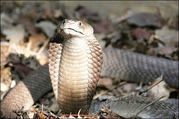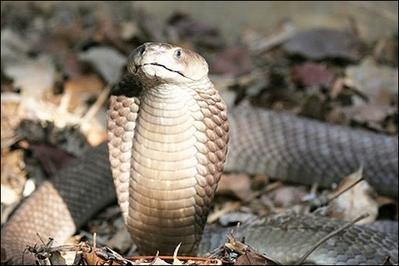Giant Spitting Cobra Discovered
Posted by: Loren Coleman on December 7th, 2007

Richard Leakey has given an excellent quotation for reflection when thinking about the foundation pursuits of cryptozoology. With regard to this new discovery, Leakey has said: “There have to be many other unreported species.”
True, indeed.
A new giant species of spitting cobra — about 2.6 metres (8.5 feet) long and with enough venom to kill up to 20 people in one bite — has been discovered in Kenya, a study said Friday.
The large brown spitting cobra, initially included under the black-necked spitting cobra species, was discovered at a snake farm in June 2004, but confirmed as a separate species this year.
The black-necked species grows to a maximum two metres (6.5 feet), with an average of 1.5 metres (4.9 feet), scientists said, making the new species the largest in the world.
The new Naja Ashei species, named after James Ashe who founded the Bio-Ken snake farm in Watamu on the Kenyan coast, produces 6.2 millilitres of liquid venom, which is the among the largest amounts of venom ever extracted from a snake at a single milking.
It confirms Ashe’s fears that the Naja Ashei was a different kind of snake that was classified under the wrong species, yet it was qualified to form its own species.
Herpetologist Wolfgang Wuster and Donald G. Bradley in a study said the new species was found in the dry lowlands of northern and eastern Kenya, northeastern Uganda, southern Ethiopia and southern Somalia.
“But the most common area you can find this species is along the Kenyan coast,” said herpetologist Royjan Taylor, who manages the Bio-Ken snake farm.

The discovery brings to six the number of African spitting cobra species, the study said.
Although cobras have the highest public profile among venomous snakes, “our understanding of the taxonomy of the group has until recently remained woefully inadequate, particularly in terms of understanding the species limits within different well-differentiated groups,” the experts said.
But after observing morphological variations between the brown and black cobras, the pair concluded that the “differences are indeed a result of the population being different evolutionary lineages.”
The discovery appears to resolve the status of the eastern and northeastern Africa species, which was the remaining puzzle in the systematics of the African spitting cobras, which were lumped into a single species in the 20th century, the experts said.
Effectively, the massive, combative and venomous Naja Ashei takes its position among the dozens of known cobra species, including the King Cobra, the longest snake in natutal habitat known to produce prodigious amounts of neurotoxin.
Experts have witnessed the new species successfully swallowing a rabbit, a two-and-half long foot monitor lizard and five-foot-long puff adder.
Taylor explained that although the new species is not listed as endangered, conservation efforts must be increased since the reptile is threatened by human activities and encroachment.
“Although I am a naturalist and conservationist who is passionate about all wildlife, my heart goes out to the reptiles that are often misunderstood — especially snakes,” he added.
Because of this discovery, he said, he would help develop anti-venom for Naja Ashei bites.
“More research work needs to be done on their venom and its implication to snakebite treatment and anti-venom manufacture,” said Taylor, whose contribution led to the new discovery.
World-renowned conservationist Richard Leakey said the discovery of the giant species was “exciting.”
“There have to be many other unreported species but hundreds are being lost as their habitats disappear under the continued mismanagement of our planet,” said Leakey. ~ by Bogonko Bosire“World’s largest spitting cobra species found in Kenya: study,” AFP, December 7, 2007.
About Loren Coleman
Loren Coleman is one of the world’s leading cryptozoologists, some say “the” leading living cryptozoologist. Certainly, he is acknowledged as the current living American researcher and writer who has most popularized cryptozoology in the late 20th and early 21st centuries.
Starting his fieldwork and investigations in 1960, after traveling and trekking extensively in pursuit of cryptozoological mysteries, Coleman began writing to share his experiences in 1969. An honorary member of Ivan T. Sanderson’s Society for the Investigation of the Unexplained in the 1970s, Coleman has been bestowed with similar honorary memberships of the North Idaho College Cryptozoology Club in 1983, and in subsequent years, that of the British Columbia Scientific Cryptozoology Club, CryptoSafari International, and other international organizations. He was also a Life Member and Benefactor of the International Society of Cryptozoology (now-defunct).
Loren Coleman’s daily blog, as a member of the Cryptomundo Team, served as an ongoing avenue of communication for the ever-growing body of cryptozoo news from 2005 through 2013. He returned as an infrequent contributor beginning Halloween week of 2015.
Coleman is the founder in 2003, and current director of the International Cryptozoology Museum in Portland, Maine.










This would be one of the scariest thing I could ever encounter. Im not afraid of snakes, but a eight foot snake that can charge with a third of its body in the air and spit very toxic venom at you from lor knows how far away. Now whats the largest cobra length recorded.
I’m not afraid of snakes either, but I’d keep a safe distance from one of these things. The longest cobra is actually the King Cobra, up to 18 feet.
Well, I am afraid of snakes. Especially the ones that are longer than I am tall!
hey everyone wow thats a huge cobra indeed.. great new article about it as well. thanks bill green
I can’t even “snake” my drain without a cold sweat. YIKES!
I love snakes and am very interested in herpetology in general. I do think that reptiles are some of the most commonly misunderstood animals and there is an incredible amount of misconceptions out there about them. Fear unfortunately can color people’s views of things and give birth to myths and misinformation. That being said, any poisonous snake like this should be treated with proper respect and given its distance.
I d not find anything at all surprising about the snake’s ability to swallow the rabbit, lizard, or adder. Snakes can swallow unbelievably large animals in comparison to their body size. It really has to be seen to be believed what they are capable of.
As far as this cobra being classified into its own species, being somewhat of a “splitter” when it comes to taxonomy (more or less meaning I favor ever more exact groupings for animals as opposed to “lumpers”, who give more morphological leeway when grouping things) this is exciting news even though the snake was already seemingly well documented under a different species name.
I love snakes. I’d like to handle this beauty.
Wow!! What a find. This has to make you wonder how many other snakes are misclassified because they kind of look and act like their similar cousins. Which then makes you wonder how many others there might be that are right under our nose and we don’t even realize it. Do you guys think this might be the case with bigfoot/sasquatch/yeti/yowi/skunkape etc. Not just one kind of bipedal primate but several unclassified very different bipedal primates. Thank to Loren and Patrick for really pointing this difference out to me. Cheers.
I don’t blame anyone for fearing cobras. However, I saw a Doberman vs Cobra clip on Fox and the Doberman won.
Hear hear!
And here’s another illustration of “if you’re looking, you find…but only if you’re looking.”
People will follow up on tag-end evidence when they EXPECT to find Something Different. The example of new peccary and manatee and clouded leopard species illustrates this well; speciation went unrecognized for a long time, despite the probability that many people were seeing these different animals. They thought, hmmmm, that one’s big, or that one’s different, but they dismissed the differences because of the similarities. Sooner or later, though, someone LOOKED into it. EXPECTING to find something really different.
There’s tons of tag-end evidence for Cryptids Not to be Named Here. But we haven’t gotten to the point where someone goes, that IS different, and I EXPECT to find it when I LOOK for it.
Science tends to go for safe bets.
Any Discovery of this magnitude is indeed welcome. i for one do not care for spitting Cobras, stay far away but let them live.
Mystery_man states that “any poisonous snake like this should be treated with proper respect and given its distance”. I agree completely; any animal deserves the respect and consideration we should offer to all of them, newly recognized or not, sweet and cuddly or not. So how long does anyone think it will be before some idiot lets one loose in Florida (probably a pregnant female)? “Never underestimate the power of human stupidity,” Robert A. Heinlein.
“Snakes… why did it have to be snakes?”
Interesting article Loren, thanks for sharing with us.
Funny quote, Dragonheart. “Asps (or cobras in this case), very dangerous. You first”. I agree, these new species articles are wonderful.
I have a quote also:
“Crikey!!!”
My favorite spitting cobra “moment” was Irwin’s Africa journey. He spent an entire episode mostly on spitting cobras. Had to wear shades constantly. Even WITH the shades, some of the venom still got to him. Great episode, great man.
Awesome find. Iw ould not wish one of those on my worst enemy.
Very Kool. I love snakes. But as said above. They should be treated with respect. Not handled like some handle them. Snake worshippers are nutts if you ask me. Anybody that will crawl into a sleeping bag or a bathtub, and fill it with deadly snakes, is not playing with a full deck if you ask me. And after these shows, what happens to the snakes ? Are they set free? No, they are butchered. Made into wallets and boots. Pretty sad I think.
Doberman vs. Cobra – well cobras are actually slow striking snakes and typically they raise to strike – that’s why a mongoose will beat a cobra, speed. Same with the dog.
With a viper the dog’s chances drop to 50-50 or less, unless he’s really fast. With the faster more aggressive elapids like the mambas, or an Aussie brown snake, I’d say all good dogs go to heaven.
Amazing that this spitting cobra was literally “in spitting distance” of science all this time and yet it still remained ‘unknown’ until now. The bigger an animal is the more problematic it becomes for it to exist without being known to science, yet, this snake is normally something that is hard to overlook. That and the herpetofauna of Kenya has been rather well known and studied the past 100 years, owing to its status as a British colony for much of that time.
An interesting thing about the evolution of the spitting cobra is that there is one line of thinking that says these cobras developed the ability and adaptation to “spit” in order to prevent being trampled on by larger animals. If, say, an antelope was about to unintentionally squash one, it is a little late to deliver a fatal bite onto the animal as it stamps down a possibly fatal or disabling blow. I suppose the same would hold true for a larger, non prey animal about to attack. The theory has it that the spitting is intended to deter such animals from getting too close to begin with and seeing as these cobras can project the venom a considerable distance, this seems very plausible. It is very much the same principle as the “rattle” of the rattlesnake. To me, it is fascinating how animals such as this have adapted to the demands and rigors of the their habitat.